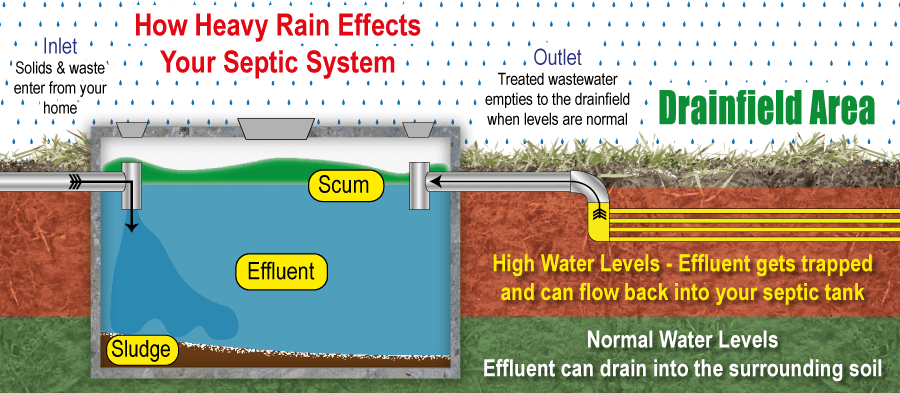In this informative article, we explore the question of whether a septic tank can become filled with water during rainy weather. Many homeowners find themselves wondering about this phenomenon as they strive to maintain a functional septic system. By understanding the potential causes and effects of a full septic tank during rainfall, you can better assess and address any potential issues that may arise. So, let’s dive right in and uncover all the essential facts!
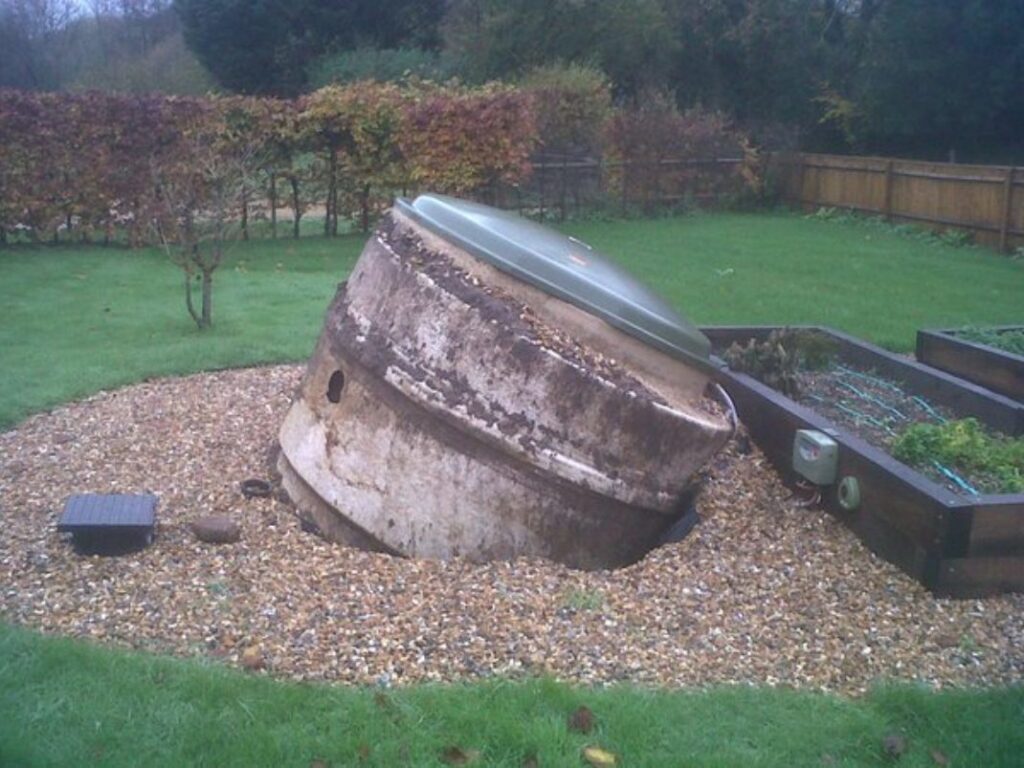
Causes of Water in Septic Tank
Leaking Tank
One of the causes of water in a septic tank is a leaking tank. If your septic tank has cracks or holes, it can allow water to enter the tank. These leaks can occur due to age, wear and tear, or damage to the tank. When rainwater enters the tank through these leaks, it can add to the water accumulation and potentially overwhelm the system.
Infiltration from Rainfall
Another common cause of water in a septic tank is infiltration from rainfall. When it rains, the excess water from the downpour can seep into the ground and make its way into the septic tank. This infiltration can happen when the soil surrounding the tank becomes saturated, allowing water to find its way into the tank. The amount of rainwater that enters the tank depends on factors such as the intensity and duration of the rainfall.
Groundwater Infiltration
Groundwater infiltration is another cause of water in a septic tank. Groundwater refers to the water that exists beneath the ground surface, usually in the saturated zone known as the water table. If your septic tank is located in an area with a high water table, the groundwater can seep into the tank, contributing to the water accumulation. Factors such as the geographical location and soil composition can influence the level of groundwater infiltration.
Symptoms of Water in Septic Tank
Slow Draining Fixtures
One of the symptoms that indicate the presence of water in a septic tank is slow draining fixtures. When there is excessive water in the tank, it can disrupt the flow of wastewater through the system. As a result, you may notice sluggish draining from sinks, showers, toilets, or other fixtures connected to the septic tank. If you experience frequent clogs and backups, it could be a sign that water is not properly draining from the tank.
Odor Issues
Water accumulation in a septic tank can lead to unpleasant odor issues. When the tank becomes inundated with water, it can hinder the proper decomposition of waste and the functioning of the beneficial bacteria. This can result in foul odors escaping from the tank and wafting into your surroundings. If you notice strong sewage-like smells in or around your property, it could indicate excess water in the septic tank.
Soggy Yard or Wet Soil
Excess water in the septic tank can also manifest itself in the form of a soggy yard or wet soil near the tank. If water from the tank is seeping out into the surrounding soil, it can create damp areas or even standing water in your yard. The presence of soggy soil or pooling water near the septic tank is a clear indication that there is an accumulation of water in the tank.
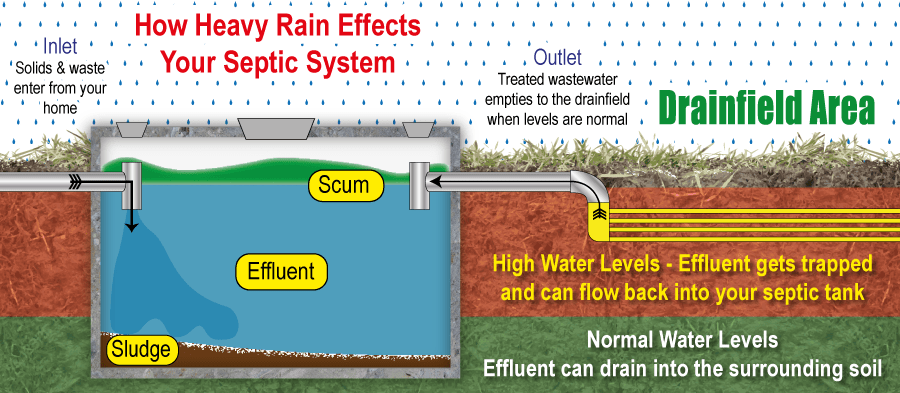
Effects of Water in Septic Tank
Reduced Bacterial Activity
Water accumulation in the septic tank can have detrimental effects on the bacterial activity crucial for the breakdown of waste. Excessive water can disrupt the balance of the septic system, diluting the concentration of bacteria responsible for breaking down solids. When there are not enough bacteria to efficiently decompose the waste, the system’s overall effectiveness is reduced, leading to potential issues such as clogs, backups, and foul odors.
Increased Maintenance and Pumping
When water enters the septic tank, it increases the workload and maintenance needs of the system. The excess water must be properly managed through regular pumping to prevent overfilling and minimize the risk of damage. The more frequently the tank needs to be pumped, the higher the maintenance costs. Additionally, the increased pumping frequency can disrupt the natural balance of the septic system, requiring more interventions to maintain its proper functionality.
Septic System Failure
If water continues to accumulate in the septic tank without proper management, it can lead to septic system failure. Over time, the excessive water can overwhelm the system’s capacity to handle wastewater and waste decomposition. This can result in backups, blockages, and potential damage to the system components. Ultimately, a septic system failure can be a costly and inconvenient problem to resolve.
Preventing Water in Septic Tank
Repairing Leaks
To prevent water from entering the septic tank through leaks, it is essential to regularly inspect and repair any cracks, holes, or damaged areas in the tank. Timely repairs can help maintain the integrity of the tank and prevent excess water infiltration. If you suspect a leak or notice any signs of water accumulation, it is recommended to consult a professional septic tank service provider for an inspection and necessary repairs.
Maintaining Drainage Systems
Proper management of rainwater and surface water is crucial for preventing water accumulation in the septic tank. Regularly maintain and ensure the proper functioning of drainage systems, such as gutters and downspouts, to divert rainwater away from the septic tank and drainfield area. Clear any debris or blockages that might hinder the flow of water. Additionally, avoid redirecting excessive water sources, such as sump pumps or roof drains, into the septic system.
Monitoring Water Usage
Being mindful of your household water usage can help prevent excessive water from overwhelming the septic system. Practice water-efficient habits, such as fixing leaky faucets and toilets promptly, using high-efficiency appliances, and avoiding excessive water usage during periods of heavy rainfall. By regulating and monitoring your water usage, you can minimize the strain on your septic tank and reduce the chances of water accumulation.

Emptying a Water-Filled Septic Tank
Calling a Professional
If you find that your septic tank is filled with an excessive amount of water, it is recommended to call a professional septic tank service provider. They have the expertise and equipment to safely assess the situation and determine the best course of action. Professional assistance is crucial to ensure proper handling of the water-filled tank and to prevent any potential harm or damage.
Pumping the Tank
To empty a water-filled septic tank, pumping is often required. A septic tank service provider will use specialized equipment to pump out the water from the tank, reducing the water level to its normal operating range. It is important to rely on professionals for this task, as they have the necessary knowledge and experience to perform the pumping safely and effectively.
Inspecting for Issues
While emptying the water-filled septic tank, it is also essential to conduct a thorough inspection for any underlying issues or damage. A professional service provider can inspect the tank, assess its condition, and identify any potential problems that may have contributed to the water accumulation. Identifying and addressing these issues early can help prevent future water-related problems and ensure the optimal functioning of the septic system.
Checking for Water in Septic Tank
Visual Inspection
One way to check for the presence of water in the septic tank is through a visual inspection. Locate the access ports or covers of the septic tank and carefully remove them. With caution, look inside the tank and check if there is an excessive amount of water. If the water level appears to be significantly higher than usual, it could indicate water accumulation.
Measuring the Tank Level
Another method to determine the water level in the septic tank is by measuring it. This method involves using a long pole or a measuring stick marked with measurements and inserting it into the tank. Gently push the pole down until it reaches the liquid or solid level in the tank. Withdraw the pole and observe the level of water present. If it exceeds the expected level, it indicates an excess of water in the tank.
Using Dye Testing
Dye testing is an effective way to identify water infiltration into the septic tank. It involves introducing a dye, such as food coloring or a specialized dye, into the plumbing fixtures connected to the septic system. After adding the dye, wait for a period of time, and then inspect the septic tank and the surrounding area for any signs of the dye. If the dye is present in the septic tank, it confirms the infiltration of water.
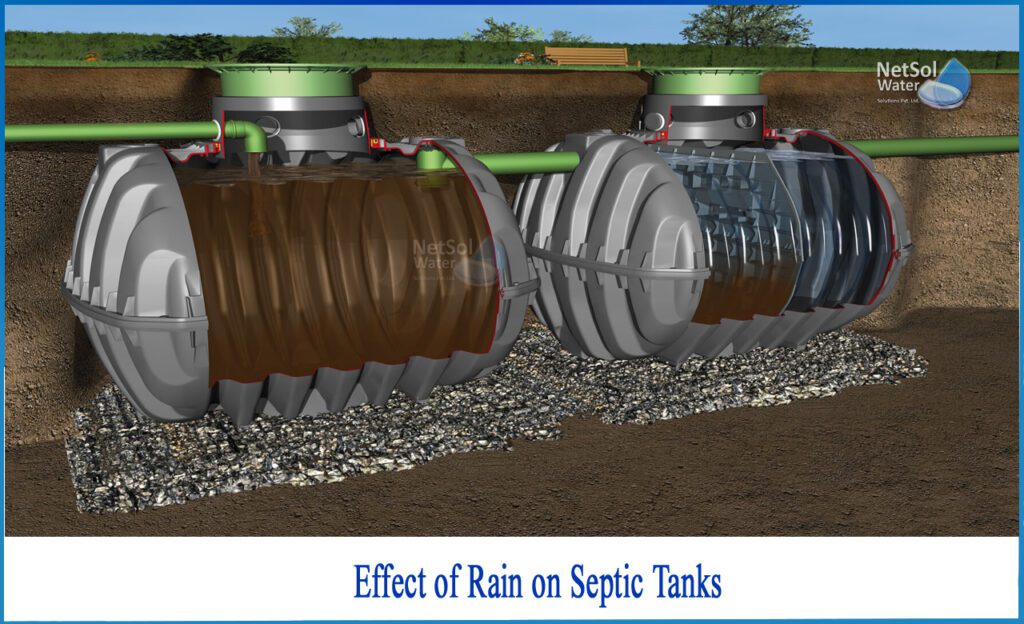
Determining the Source of Water in Septic Tank
Professional Inspection
To accurately determine the source of water in the septic tank, it is recommended to seek a professional inspection. A qualified septic system inspector can assess the entire system, including the tank, drainfield, and surrounding areas. They will inspect for potential causes such as leaks, cracks, damage, or faulty components. The inspector’s expertise and experience will help pinpoint the exact source of the water and provide appropriate recommendations for resolution.
Eliminating Other Possibilities
Before concluding that the water in the septic tank is solely due to septic system-related issues, it is important to eliminate other possibilities. Excessive rainfall, plumbing leaks, or surface water runoff can sometimes be mistaken for water accumulation in the septic tank. Assessing these external factors and ruling them out can ensure an accurate identification of the source of water in the tank.
Groundwater Testing
If groundwater infiltration is suspected as a potential cause of water in the septic tank, conducting groundwater testing can provide valuable insights. This testing involves analyzing the water table levels and evaluating the rate at which groundwater enters the septic tank. Professionals can employ specialized tools and techniques to measure groundwater levels and determine the extent of infiltration. This information can help guide appropriate solutions for managing and mitigating groundwater infiltration.
Managing Water in Septic Tank with Rainwater Harvesting
Installing a Rainwater Collection System
One way to manage water in the septic tank, particularly from rainfall, is by installing a rainwater collection system. This system involves capturing rainwater from rooftops and other surfaces and directing it into a storage tank or reservoir. By collecting rainwater separately, you can reduce the amount of water entering the septic tank. Furthermore, the harvested rainwater can be used for non-septic purposes, thereby minimizing the strain on the septic system.
Using Rainwater for Non-Septic Purposes
Once rainwater is collected, it can be utilized for various non-septic purposes. This includes outdoor watering, gardening, irrigation, and other activities that do not require potable water. By using harvested rainwater for such purposes, you can decrease the reliance on the septic system for water disposal and lessen the overall water volume entering the septic tank.
Benefits of Rainwater Harvesting
Rainwater harvesting offers several benefits, including water conservation, reduced strain on the septic system, and decreased dependence on municipal water supplies. It allows you to harness a natural resource and utilize it efficiently for non-potable purposes. Implementing rainwater harvesting practices can contribute to sustainable water management and promote environmental stewardship.
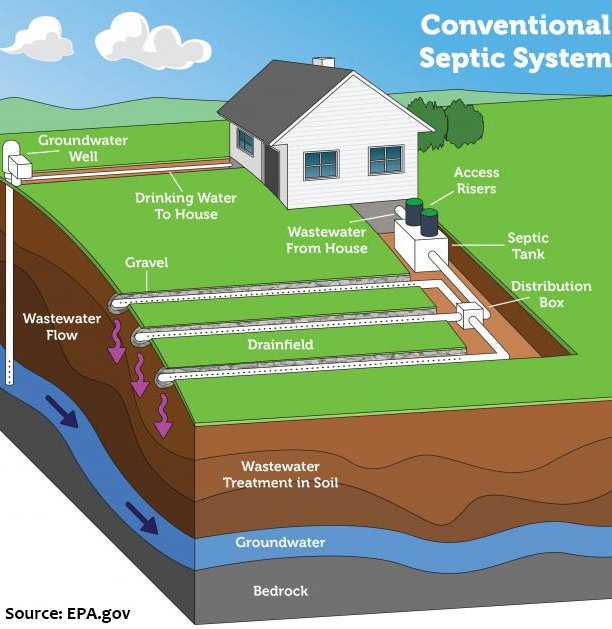
Common Misconceptions about Water in Septic Tank
Rainwater Instantly Overflows the Tank
A common misconception is that rainwater instantly causes the septic tank to overflow. While excessive rainfall can contribute to water accumulation in the septic tank, it does not automatically lead to an immediate overflow. The septic tank is designed to hold a certain amount of water before it needs to be pumped. However, continuous heavy rainfall can increase the risk of overfilling and potential issues if the water is not properly managed.
Septic Systems Cannot Handle Rainwater
Another misconception is that septic systems are not equipped to handle rainwater. In reality, septic systems are designed to accommodate normal water inputs, including water from rainfall. With proper maintenance, drainage management, and monitoring, septic systems can effectively handle both household wastewater and a reasonable amount of rainwater infiltration. However, excessive water from heavy rainfall can overwhelm the system and pose challenges if not adequately managed.
Only Heavy Rain Leads to Water in Tank
Contrary to popular belief, heavy rain is not the only factor contributing to water accumulation in the septic tank. Even moderate or prolonged rainfall can gradually saturate the soil around the tank, leading to water infiltration. It is important to recognize that water accumulation can occur not only during intense storms but also during more mild or consistent rainy periods. Proper septic system maintenance and water management are essential regardless of the rainfall intensity.
Conclusion
Water in a septic tank can be caused by various factors, such as leaking tanks, infiltration from rainfall, and groundwater infiltration. Recognizing the symptoms, such as slow draining fixtures, odor issues, and a soggy yard, is crucial for timely intervention and preventing further complications. The effects of water in the septic tank can include reduced bacterial activity, increased maintenance and pumping needs, and even septic system failure. To prevent water in the septic tank, it is important to repair leaks, maintain drainage systems, and monitor water usage. If a water-filled septic tank needs to be emptied, seeking professional assistance, pumping the tank, and inspecting for underlying issues are necessary steps. Checking for water in the septic tank can be done through visual inspection, measuring the tank level, or using dye testing. Determining the source of water in the tank often requires professional inspection, elimination of other possibilities, and potentially groundwater testing. Rainwater harvesting can be an effective strategy for managing water in the septic tank by installing a collection system and utilizing the harvested rainwater for non-septic purposes. It is important to dispel common misconceptions, such as rainwater instantly overflowing the tank or septic systems being unable to handle rainwater. With proper understanding, management, and maintenance, the challenges associated with water in a septic tank can be mitigated, ensuring the optimal functioning and longevity of the septic system.
